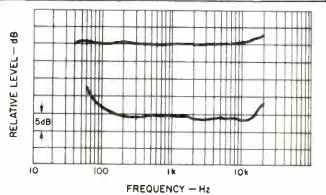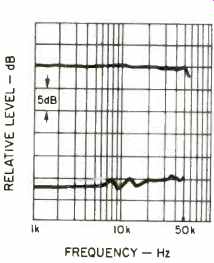
Manufacturer's Specifications:
Type: XC/van den Hul stylus, nude mounted, grain oriented.
Frequency Response: 20 Hz to 20 kHz ± 1 dB.
Channel Separation: 25 dB from 200 Hz to 10 kHz; 20 dB from 10 kHz to 20 kHz.
Channel Balance: Within 1 dB.
Output: 2.5 mV for 5 cm/S, peak velocity.
Tracking Ability: 70 µm at 1.8 g, 300 Hz.
Effective Tip Mass: 0.27 mg.
Tip Dimensions: 3.5 µ x 85 µ.
Cartridge Weight: 4.7 g.
Load Impedance: 47 kilohms (non-critical).
Vertical Tracking Angle: 20°.
Tracking Force: 1.9 g
Square Wave Rise-Time: 10 µS.
Dynamic Compliance: 13 x 10^-6 cm/ dyne at 400 Hz.
Price: $400.00.
--- ---
The Adcom Crosscoil phono cartridge reviewed here is the second U.S. cartridge to be fitted with the new stylus tip developed and designed by A.J. van den Hul of Delft, The Netherlands. The shape of this stylus tip resembles that of the cutter, but instead of the cutter's 2 micron radius, the van den Hul stylus tip has a radius of about 4 microns. Because of this small front-to-back contact radius, only a very small part of the record groove is traced at any one time, with only one specific moment of tracking for any portion of the groove. Thus, the tip movement is precisely the same as the groove modulation. The vertical groove contact line is exactly vertical with no curvature, and its radius measures 85 microns. I recently had an opportunity to examine some Scanning Electron Microscope (SEM) scaled pictures of the van den Hul stylus tip and found the overall vertical groove contact radius measured 143 microns, while the front-to-back contact radius measured 5 microns. (For further discussion of the van den Hul stylus tip see my comments in Audio November 1981, page 62.) The Adcom XC/van den Hul moving coil phono cartridge is packaged in a well-built case along with a stylus brush, small screwdriver, a headshell weight, gold-plated connectors, and suitable hardware for mounting the cartridge in a headshell. The cartridge has a removable stylus guard. As in almost all moving-coil cartridges, the stylus assembly is not user replaceable. The cartridge is fitted with a unique Crosscoil design that significantly increases its output, thus eliminating the need for a step-up device. The generating coils for the two channels are wound around an "X" shaped armature instead of the conventional cube form, effecting a very considerable reduction in weight. The "X" shape permits many more turns of wire to be wound on each of the crosspieces without a large increase in weight, thus generating a larger output. The Crosscoil design has enough output to drive the standard magnetic phono input of a preamplifier without the need for a step-up transformer or a pre-preamplifier. It is claimed that the "X" shape insures greater uniformity of output between channels, as well as excellent channel separation. It is further claimed that an important advantage of the Crosscoil design is controlled damping, since the linkage between the "X"-shaped armature and the elastomer damping block permits smoother, less impeded movement of the entire stylus assembly with a consequent improvement in the midrange transient response. The cantilever shank is a high-strength aluminum alloy tube drawn in a thin wall configuration. It is considered to have an exceedingly low mass per unit of cantilever length, and its stiffness is optimized to produce a smooth flat frequency response.
Measurements
The Adcom XC/van den Hul moving coil phono cartridge was mounted in a Technics headshell and used with the Technics EPA-100 tonearm mounted on a Technics SP-10 MkII turntable. The cartridge was oriented in the headshell and tonearm with the Dennesen Geometric Soundtracktor. Because the stylus requires precise vertical alignment, it is necessary to place a thin, flat mirror on the turntable, place the cartridge on the mirror surface, and observe the vertical white line on the front of the cartridge body with its reflection in the mirror. The white lines should be lined up in a straight vertical line (not canted to one side or the other) for correct vertical alignment. The red dot on either side of the cartridge body indicates the location of the stylus while playing a record.
Laboratory tests were conducted at an ambient temperature of 70° F ± 0° (21 ° C) and a relative humidity of 66 percent ± 0 percent. The tracking force for all reported tests was 2.1 grams, with an anti-skating force of 2.5 grams. As is our practice, measurements are made on both channels, but only the left channel is reported unless there is a significant difference between the two channels, in which case both channels are reported for a given measurement.
The following test records were used in making the reported measurements: Columbia STR-170, STR-100, STR112; Shure TTR-103, TTR-109, TTR110, TTR-115; Deutsches No. 2, Nippon Columbia Audio Technical Record (PCM) XL-7004; JVC TRS-1005, and the Ortofon Pickup Test Records 0001 and 0002.

Fig. 1--Frequency response and separation with the CBS STR-170 test disc.

Fig. 2--Response and separation with the JVC TRS-1005 record.

Fig. 3--Response to 1-kHz square wave from CBS STR-112.
Frequency response, using the Columbia STR-170 test record, Fig. 1, was-0, +1.25 dB from 40 Hz to 11 kHz, +1 dB at 15 kHz, and +2.25 dB at 20 kHz. Separation was 20.25 dB at 1 kHz, 21 dB at 5 kHz, 22.5 dB at 10 kHz, 20.75 dB at 15 kHz, and 19.75 dB at 20 kHz. Using the JVC TRS-1005 test record, Fig. 2, sweeping from 1 kHz to 50 kHz, the frequency response was-1, +0 dB from 1 kHz through 20 kHz, +0.25 dB at 30 kHz,-0.25 dB at 40 kHz, and +1 dB at 50 kHz. Separation was 28.75 dB at 1 kHz, 27 kHz at 10 kHz, 24 dB at 20 kHz, 21 dB at 30 kHz, 24.75 dB at 40 kHz, and 23.25 dB at 50 kHz. From these data, it is quite evident that this Adcom cartridge has an excellent frequency response and a very satisfactory high-frequency separation.
The 1-kHz square-wave response shows a large overshoot followed by ringing that represents the inherent error in this test record at about 42 to 45 kHz, which was probably generated by the cutterhead when cutting the record. The large overshoot is possibly due to the underdamped high-frequency resonances of the cartridge. The cartridge-arm low frequency lateral resonance is at 7 Hz at +3 dB amplitude. The vertical resonance is at about 7 Hz. Both the lateral and vertical resonances were measured with the Technics EPA-100 tonearm.
Wt., 4.9 g; opt. tracking force, 2.1 g; anti-skating force, 2.5 g; output, left: 0.65, right: 0.71 mV/cm/S; IM distortion: (4:1) +9 dB lateral, 200/4000 Hz, left: 1 .2 percent, right: 4.2 percent; +6 dB vertical , 200/4000 Hz, left: 2.6 percent, right: 3.4 percent; crosstalk (using Shure TTR-109), -30 dB; channel balance, within 0.75 dB; trackability: high freq. (10.8 kHz, pulsed), 30 cm/S, mid-freq. (1000 and 1500 Hz, lat. cut), 31.5 cm/S, low freq. (400 and 4000 Hz, lat. cut), 24 cm/S; Deutsches Hi-Fi No. 2, 300-Hz test band was tracked cleanly to 86 microns (0.0086 cm) lateral at 16.2 cm/S at +9 dB and 43.1 microns (0.00431 cm) vertical at 8.12 cm/S at 3.64 dB.
The Adcom XC/van den Hul phono cartridge played all the test bands cleanly on the Shure Obstacle Course Era Ill musical test record. On the Shure Obstacle Course Era IV musical test record, the cartridge experienced some difficulty in playing level 5 of the harp, harp and flute, and flute and bells test bands. Needless to say, the cartridge played very well inasmuch as level 5 peak recorded velocities for the combined instruments exceed 45 cm/S and 50 cm/S, respectively. The peak recorded velocity of commercial records averages about 15 cm/S.
Use and Listening Tests
As usual, I listened to the cartridge both before and after measurement. The cartridge was able to cleanly reproduce The Sheffield Drum Record (Lab 14) and all the cannon shots on the Tchaikovsky 1812 recording (Telarc DG-10041), which are remarkable feats. In general, the cartridge acquitted itself very well, particularly in transient response, applause definition, sonic clarity, well-defined bass, transparency of sound, and very good stereo imaging. I did not encounter any apparent coloration or audible distortion that was introduced by the cartridge while playing records. After considerable measurements and listening tests, I am convinced that the van den Hul stylus, though it may be considered radical in some quarters, is a significant contribution to the fine musicality of the Adcom XC/van den Hul moving-coil phono cartridge.
-B.V. Pisha
(Audio magazine, Jan. 1982)
Also see:
Van Den Hul Type I Phono Cartridge (July 1984)
A Clutch of Cartridge (Adcom, Grado, Talisman and Decca) (Feb. 1986)
Decca London International Tonearm & Mk VI Gold Elliptical Phono Cartridge (Aug. 1979)
= = = =